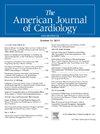Eight-Year Outcomes of Patients With Reduced Left Ventricular Ejection Fraction Who Underwent Transcatheter Aortic Valve Replacement With a Self-Expanding Bioprosthesis
IF 2.3
3区 医学
Q2 CARDIAC & CARDIOVASCULAR SYSTEMS
引用次数: 0
Abstract
Data deriving from patients who underwent TAVR between 2007 and 2017 in 13 Italian centers were prospectively collected. Patients were stratified in those with normal LVEF and reduced LVEF. The latter was further classified according to ischemic or nonischemic etiology. The primary end point was a composite of all-cause death and rehospitalizations; the secondary end points were the isolated composers of the primary end point and cardiac death. Overall, 2,626 patients were included in the analysis: 68.1% with normal LVEF and 31.9% with reduced LVEF. At 8 years, reduced LVEF was significantly associated with the primary end point (adjusted hazard ratio 1.17, 95% confidence interval 1.06 to 1.29). Consistent findings were evident for the composite end point. No differences in these trends were found at the 30-day landmark analyses. Compared with nonischemic etiology, ischemic reduced LVEF was associated with an increased risk of cardiac death (adjusted hazard ratio 1.43, 95% confidence interval 1.02 to 2.02). In conclusion, patients with reduced LVEF who underwent TAVR are exposed to a progressively increased risk of death and rehospitalizations, even at very long-term follow-up.
接受经导管主动脉瓣置换术并使用自膨胀生物假体的左心室射血分数降低患者的八年预后。
关于接受经导管主动脉瓣置换术(TAVR)的患者左心室射血分数(LVEF)受损与不良预后之间的关系,目前报道的结果相互矛盾,而且缺乏长期临床数据。本研究旨在调查接受 TAVR 术的 LVEF 降低患者的长期预后。 研究人员前瞻性地收集了 2007 年至 2017 年期间在 13 个意大利中心接受 TAVR 术的患者的数据。患者分为 LVEF 正常和 LVEF 降低两类。后者根据缺血或非缺血病因进一步分类。主要终点是全因死亡和再次住院的复合终点,次要终点是主要终点和心源性死亡的单独复合终点。共有2626名患者参与了分析,其中68.1%的患者为NLVEF,31.9%的患者为LVEF降低。八年后,LVEF降低与主要终点显著相关(adj. HR 1.17 95% CI 1.06-1.29)。对于复合终点,研究结果一致。在30天的地标分析中,这些趋势没有发现差异。与非缺血性病因相比,缺血性 LVEF 降低与心源性死亡风险增加有关(adj. HR 1.43 95% CI 1.02-2.02)。总之,接受 TAVR 的 LVEF 降低的患者即使在长期随访中,其死亡和再次住院的风险也会逐渐增加。
本文章由计算机程序翻译,如有差异,请以英文原文为准。
求助全文
约1分钟内获得全文
求助全文
来源期刊

American Journal of Cardiology
医学-心血管系统
CiteScore
4.00
自引率
3.60%
发文量
698
审稿时长
33 days
期刊介绍:
Published 24 times a year, The American Journal of Cardiology® is an independent journal designed for cardiovascular disease specialists and internists with a subspecialty in cardiology throughout the world. AJC is an independent, scientific, peer-reviewed journal of original articles that focus on the practical, clinical approach to the diagnosis and treatment of cardiovascular disease. AJC has one of the fastest acceptance to publication times in Cardiology. Features report on systemic hypertension, methodology, drugs, pacing, arrhythmia, preventive cardiology, congestive heart failure, valvular heart disease, congenital heart disease, and cardiomyopathy. Also included are editorials, readers'' comments, and symposia.
 求助内容:
求助内容: 应助结果提醒方式:
应助结果提醒方式:


